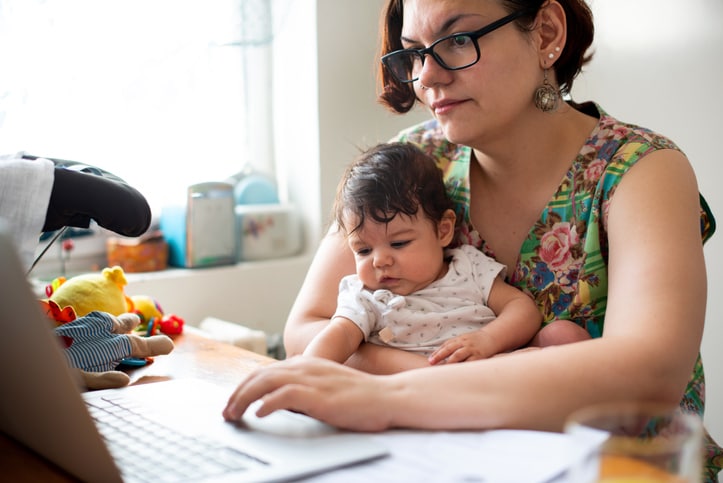In this article
Many parents have family members care for their children, part- or full-time. In addition to the emotional benefits that come with a close-knit family, having a family member, such as a grandparent or aunt, provide child care can help offset the (often wildly high) price of professional child care. However, family members can get paid for child care — and parents don’t necessarily need to foot the bill.
“As long as the person providing care isn’t a sibling also being claimed as a dependent, family members are eligible for payment through programs, such as the Child and Dependent Care Credit,” explains Katrina Martin, owner of Wow Tax and Advisory Service in Southfield, Michigan.
Wondering how to get paid for babysitting by the state, or if there are federal programs that pay family members to provide care? Here, experts break down how to get paid from the state to babysit and more.
Key takeaways
- Relatives can be paid for child care through state programs or private arrangements, though requirements like background checks or training often apply.
- Payment amounts differ by state, with subsidies ranging from a few hundred to over $1,000 a month.
- Parents who pay relatives directly may also claim the Child and Dependent Care Credit to reduce their tax bill.
Can a family member get paid for child care?
Yes, it is possible for family members to be compensated as child care providers, notes Chad Cummings, a tax attorney and certified public accountant serving clients in Florida and Texas. That said, rules, programs and amounts vary by state (more on this shortly).
“While many states allow relatives, such as grandparents or adult siblings, to be paid for caring for a child, it’s not automatic,” he explains. “The family member must be formally engaged through a specific program or hired as a caregiver to receive payment.”
How to get paid for family child care
In order to be paid from the state, family members typically must undergo a background check, complete an application with the state and occasionally take part in a training of some sort (again, state rules vary).
Using New Jersey as an example, the Child Care Assistance Program (CCAP) allows family members to be paid as child care providers, so long as they participate in pre-service training, have current CPR and First Aid certification and submit a medical clearance form, in addition to other prerequisites.
“The family member must be formally engaged through a specific program or hired as a caregiver to receive payment.”
— Chad Cummings, tax attorney and certified public accountant
Another example: Oregon’s Employment Related Day Care (ERDC), which allows parents to choose a family member as a child care provider. Providers need to complete a background check and take an online safety course.
Additionally, parents can privately pay family members who are child care providers. In such a case, though, the family member may be considered a household employee (depending on the number of hours worked) and taxes would need to be withheld.
For families that go this route, it’s important to “keep proper documentation of payments and the caregiver’s social security number or tax ID,” notes Cummings.
What programs provide payment?
Several public programs pay family caregivers, notes Cummings with one major avenue being state child care assistance programs that “help working parents with child care costs.”
State child care assistance
“These programs often allow relatives to serve as the paid provider,” he explains. “For example, Florida has the School Readiness program and Texas has Child Care Connection.”
To find out what programs are available in your state, check out Child Care Aware’s state program assistance map.
Note: Many of these state programs are federally funded through the Child Care and Development Fund (CCDF), which allows states to decide who is eligible.
Kinship caregiver support
Another route is kinship caregiver support, adds Cummings. “Many states offer stipends to relatives who assume custody of children when parents cannot,” he explains. “In special situations, certain Medicaid waivers also allow a family member to be paid for caring for a child with disabilities.”
How much can a family member get paid for child care?
“Subsidy programs typically pay relatives a fixed rate per hour or day, often lower than standard daycare rates, which can be around $15 per day in some areas,” Cummings explains, adding: “Payment amounts depend on the program and state, generally following state-set rates or stipends.”
Using Oregon as an example again, the monthly reimbursement for child care (including to relatives) is $375. In New Jersey, rates vary, based on the child’s age, hours worked and more.
“Kinship guardian programs pay a flat monthly amount per child,” Cummings notes. “Florida’s relative caregiver benefit is roughly $250 to $300 per month per child, whereas Texas offers about $700 per month (for the first year of care) to relatives.”
“Rules vary widely by state,” he continues. “Some require background checks, training or even foster parent licensing for a family member to qualify.”
“Families should contact their state’s child care or social services agency to learn about available programs and how to apply. Additionally… be sure to keep clear records of the care arrangement and payments to meet program requirements.”
— Chad Cummings
How can the Child and Dependent Care Credit (CDCC) help?
For parents privately paying a relative to provide child care, Martin notes, the Child and Dependent Care Credit can help by lowering their taxes that are owed.
“The credit is a percentage of your care expenses, ranging from 20-35%,” Martin explains. “The maximum expenses parents can claim are $3,000 for one qualifying individual, $6,000 for two or more qualifying individuals.”
Of course, there are stipulations. “Parents cannot claim this credit if the caregiver is their spouse, the child’s parent (living in another home) or someone you can claim as a dependent, such as a sibling under 19.”
One last tip about getting paid for child care
While it’s a little convoluted to figure out how to get paid for babysitting by the state as a relative, it’s worth it because you’re then getting paid for your work as a provider (regardless of how much you love it). And, if you’re a parent, you’re cutting costs and/or alleviating some of the guilt you may feel having a loved one care for your kids unpaid.
“Families should contact their state’s child care or social services agency to learn about available programs and how to apply,” says Cummings. “Additionally, gather required documentation and be sure to keep clear records of the care arrangement and payments to meet program requirements and support any tax claims.”





